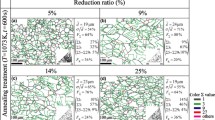Abstract
In order to characterize quantificationally the wear topography of the brazed polycrystalline cBN (PcBN) grains during grinding, the reconstruction model of grain topography is established through the photographs grasped with three-dimensional (3D) optical video microscope. The relationship between 3D fractal dimension and the complicated topography change of the PcBN grains is investigated based on fractal theory. The results obtained show that it is reasonable to calculate 3D fractal dimension according to the protrusion height of the abrasive grain. The fractal dimension of the grain wear topography formed due to microfracture is higher than that formed due to large fracture and attritious wear. The fractal dimension range of the wear topography of the brazed PcBN grains is limited to 2.0325–2.0475 with a concentrated value of 2.04 under the present experimental condition.
Similar content being viewed by others
References
Dub SN, Petrusha IA (2006) Mechanical properties of polycrystalline cBN obtained from pyrolytic gBN by direct transformation technique. High Pres Res 26(2):71–77
Ding WF, Xu JH, Chen ZZ, Su HH, Fu YC (2011) Grain wear of brazed polycrystalline cBN abrasive tools during constant-force grinding Ti-6Al-4V alloy. Int J Adv Manuf Technol 52:969–976
Bhaskar P, Chattopadhyay AK, Chattopadhyay AB (2010) Development and performance evaluation of monolayer brazed cBN grinding wheel on bearing steel. Int J Adv Manuf Technol 48:935–944
Ichida Y, Fujimoto M, Inoue Y, Matsui K (2010) Development of a high performance vitrified grinding wheel using ultrafine-crystalline cBN abrasive grains. J Adv Mech Des Syst Manuf 4:1005–1014
Webster J, Tricard M (2004) Innovation in abrasive product for precision grinding. Annals of the CIRP 53(2):597–617
Bhaduri D, Kumar R, Chattopadhyay AK (2011) On the grindability of low-carbon steel under dry, cryogenic and neat oil environments with monolayer brazed cBN and alumina wheels. Int J Adv Manuf Technol 57:927–943
Zhang B, Ding WF, Xu JH, Pan Q, Shi YJ (2011) Self-sharpening abrasive composite bulks with PcBN grains. Key Eng Mater 487:220–224
Linke B, Klocke F (2010) Temperatures and wear mechanisms in dressing of vitrified bonded grinding wheels. Int J Mach Tool Manuf 50:552–558
Bewilogua K, Brauer G, Dietz A, Gabler J, Goch G, Karpuschewski B, Szyszka B (2009) Surface technology for automotive engineering. CIRP Ann Manuf Technol 58:608–627
Mao C, Zhou ZX, Zhang J, Huang XM, Gu DY (2011) An experimental investigation of affected layers formed in grinding of AISI 52100 steel. Int J Adv Manuf Technol 54:515–523
Abdolbamid A, Seyed MR, Abdolreza R (2010) Study on the rotary cup dressing of CBN grinding wheel and the grinding performance. Int J Adv Manuf Technol 47:1053–1063
Yan L, Rong YM, Jiang F, Zhou ZX (2011) Three-dimension surface characterization of grinding wheel using white light interferometer. Int J Adv Manuf Technol 55:133–141
Cai R, Rowe WB (2004) Assessment of vitrified CBN wheels for precision grinding. Int J Mach Tool Manuf 44:1391–1402
Nasaki I (1996) Grinding process simulation based on the wheel topography measurement. CIRP Ann 45:347–350
Jimoto M, Ichida Y, Sato R, Morimoto Y (2006) Characterization of wheel surface topography in cBN grinding. JSME Int J 49:106–113
Stachowiak GW, Podsiadlo P (2001) Characterization and classification of wear particles and surfaces. Wear 249:194–200
Sayles RS, Thomas TR (1978) Surface topography as a non-stationary random process. Nature 271:431–434
Zahouni H, Vargiolu R, Loubet JL (1998) Fractal models of surface topography and contact mechanics. Math Comput Model 28:517–534
Nayak PR (1971) Random process model of rough surfaces. J Lubr Technol Trans ASME 93:398–407
Zahouani H, Vargiolu R, Kapsa PH, Loubat JL, Mathia TG (1998) Effect of lateral resolution on topographical images and three-dimensional functional parameters. Wear 219:114–123
Podsiadlo P, Stachowiak GW (2000) Scale-invariant analysis of tribological surfaces, thinning films and tribological interfaces. Tribol Ser 38:546–557
Mandelbrot BB (1967) How long is the coast of Britain? Statistical self-similarity and fractional dimension. Science 156:636–638
Mandelbrot BB, Passoja DE, Paullay AJ (1984) Fractal characterization of fracture surfaces of metals. Nature 308:1571–1572
Panda CS, Richards LR (1987) Fractal characteristics of fractured surfaces. J Mater Sci Lett 6:295–297
Florindo JB, Backes AR, Castro M, Bruno OM (2012) A comparative study on multiscale fractal dimension descriptors. Pattern Recognit Lett 33:798–806
James GM, Davide M (2010) Fractal geometry in the nucleus. EMBO J 29(1):2–3
Liang XH, Lin B, Han XS, Chen SG (2012) Fractal analysis of engineering ceramics ground surface. Appl Surf Sci 258:6406–6415
Fiete GA, Lozanne AD (2010) Seeing quantum fractals. Science 327:652–653
Zhang Y, Luo Y, Wang JF, Li Z (2001) Research on the fractal of surface topography of grinding. Int J Mach Tool Manuf 41:2045–2049
Charkaluk E, Bigerelle M, Iost A (1998) Fractals and fracture. Eng Fract Mech 61:119–139
Russ JC (1994) Fractal surfaces. Plenum Press, New York
Peng Z, Kirk TB, Xu ZL (1997) The development of three-dimensional imaging techniques of wear particle analysis. Wear 203–204:418–424
Podsiadlo P, Stachowiak GW (1997) Measurement and characterization of wear particle surface topography. Proceedings of the First World Tribology Congress, London Publications Ltd
Fujimoto M, Ichida Y (2008) Micro fracture behavior of cutting edges in grinding using single crystal cBN grains. Diam Relat Mater 17:1759–1763
Pande CS, Richards LR (1987) Fractal characteristics of fractured surfaces. J Mater Sci Lett 6:295–297
Ichida Y, Sato R, Fujimoto M, Tanaka H (2008) Fractal analysis of grain cutting edge wear in superabrasive grinding. J Adv Mech Des Syst Manuf 2(4):640–650
Ding WF, Xu JH, Chen ZZ, Fu YC, Su HH (2010) Relationship between embedding depth and residual stress in the cBN grain of monolayer brazed abrasive tools. J Mater Eng Perform 19(1):123–128
Daniela H, Jan K (2009) Influence of vitrified bond structure on radial wear of cBN grinding wheels. J Mater Process Technol 209:5377–5386
Jackson MJ (2004) Microscale wear of vitrified abrasive materials. J Mater Sci 39:2131–2143
Author information
Authors and Affiliations
Corresponding author
Rights and permissions
About this article
Cite this article
Miao, Q., Ding, W.F., Xu, J.H. et al. Fractal analysis of wear topography of brazed polycrystalline cBN abrasive grains during grinding nickel super alloy. Int J Adv Manuf Technol 68, 2229–2236 (2013). https://doi.org/10.1007/s00170-013-4823-2
Received:
Accepted:
Published:
Issue Date:
DOI: https://doi.org/10.1007/s00170-013-4823-2



